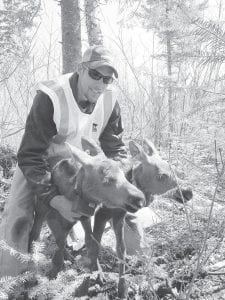The Minnesota Department of Natural Resources moose calf mortality study last spring captured and fitted 49 young moose with expandable collars. The calves, like this set of twins, were at least 36 hours old, however scientists now wonder if that was too young. The death of 11 calves is attributed to the trauma of being collared. Should the study be funded next spring, researchers are contemplating waiting longer before capturing and collaring the calves. There are only nine moose calves still alive in the monitoring group.

First the bad news: only nine out of the 49 moose calves fitted last spring with radio transmitting collars containing, among other things, GPS signaling devices, remain in the Minnesota Department of Natural Resources (DNR) calf mortality study. Now the good news: only one calf has been killed in the last three months.
“The most recent [calf] was a collared male, wounded by wolves, then about three weeks later it died on November 26, 2013 from a fatal infection caused by the wounds,” said Glenn DelGiudice, Ph.D., Research Scientist/Moose Project Leader, Forest Wildlife Populations and Research Group.
“This brings the total natural mortality rate to 74 percent (25 of 34 calves)—22 of these [killed] by predators,” added DelGiudice.
Very early on researchers found that 11 calves’ deaths could be attributed to the trauma of being collared. Most were fitted with collars within 36 hours of their birth. Should the study be funded next spring, researchers are contemplating waiting longer before capturing and collaring the calves.
The calf study dovetails with an adult study of 103 moose also fitted with collars that also contain GPS tracking devises. When moose stop moving for a period of six hours researchers assume it is dead and a crew is dispatched to retrieve it. The goal is to do so within 24 hours so they can determine why the moose has perished. If they wait longer, predators will almost certainly have eaten the moose carcass.
Besides the 11 calves abandoned by their mothers (due to being trapped and collared), four other calves slipped their collars and one was abandoned for unknown reasons. Over the summer researchers discovered 16 calves eaten by wolves, four killed by bears, one dead from drowning, one abandoned by its mother, one killed by an unknown predator and one dead from unknown reasons, leaving 10 left to be tracked.
Wildlife researchers are in a mad scramble to figure out what is killing Minnesota’s moose. In 2006 the Minnesota DNR estimated there were 8,840 moose in northeastern Minnesota. That figure dropped to an estimate of 2,760 for 2013. In the northwestern part of Minnesota, the moose herd plunged from 2,000 in the 1990s to less than 50 today.
With the moose dying so fast of unknown causes, the DNR suspended the bulls-only moose hunt for 2013. The Grand Portage Band of Lake Superior Chippewa and the Fond du Lac Band of Chippewa also canceled their subsistence moose hunts on lands covered by the 1854 Treaty. Both bands work hand in hand with the DNR on moose research and help fund portions of the various studies being conducted.
In an effort to help restore the population, Grand Portage is also currently managing 47,000 acres of moose habitat and the U.S. Forest Service is managing 40,000 acres for moose in the Greenwood Lake area.
On August 19, 2013, the DNR announced that for the first time moose had been added to the state’s endangered species list and placed in the “species of special concern” column. A species of special concern is one that is considered threatened but is not seen at immediate risk.
At the end of the summer DelGiudice was asked what he expected the study to show at the conclusion of one year. He answered, “Can’t say, we’re already at 71 percent natural mortality rate [24 of 34 killed by predators]— that’s close to what we were expecting over the entire year. What happens by next May depends on winter severity, etc. …So the mortality hit by predators has been fairly significant, but this is just one spring-summer, so these data can only be interpreted within the context of this year and the environmental conditions and variability that occurred this year.
“Also, we don’t know for sure how representative of the populations this study cohort is. That’s why multiple years of study are needed. Additionally, documenting calf/cow ratios during the annual moose survey in January may give us a better idea if this calf survival rate is representative of the population,” said DelGiudice.


Leave a Reply